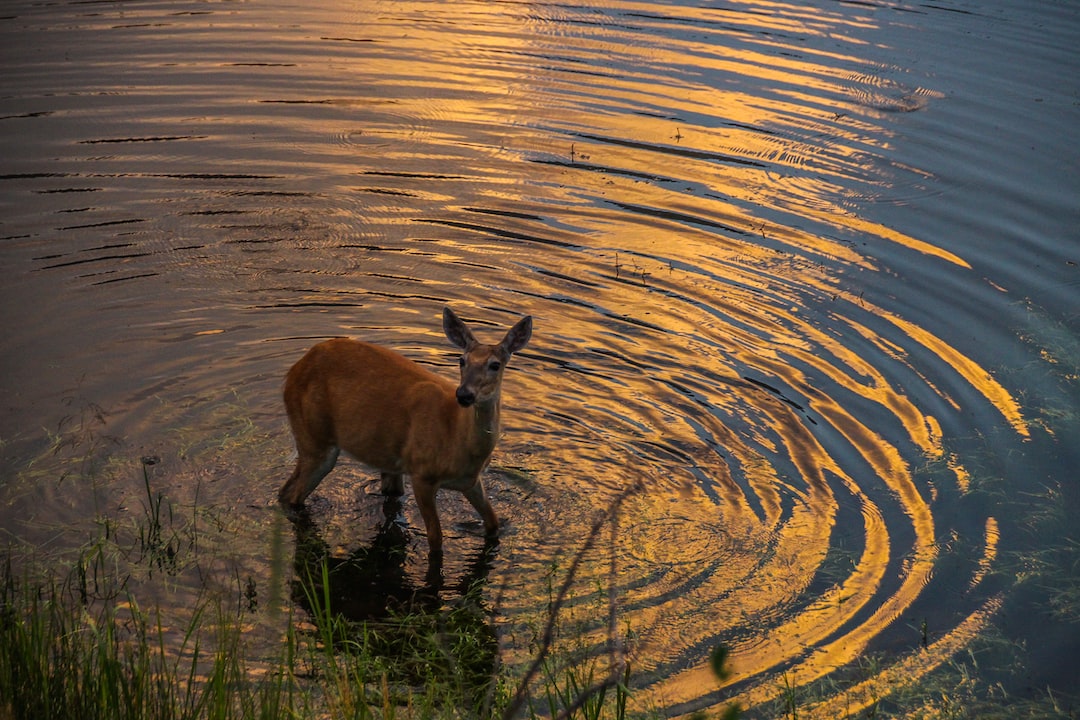Can deer swim? It’s a question that has puzzled hunters and outdoors enthusiasts for centuries.
Surprisingly, deer can swim short distances when necessary. While it might not be something we see every day, deer are actually capable of swimming short distances when necessary.
We’ll explore why they do this, what safety tips should be taken into account by those hunting near water sources, and dive deeper into the anatomy of these fascinating creatures to better understand their behavior in aquatic environments.
So join us as we investigate if and how deer can really swim.
Anatomy of a Deer
Wildlife abounds, and deer are one of the most ubiquitous creatures that have adapted to a range of habitats. To understand why deer can swim, it’s important to first look at their anatomy.
Deer have physical characteristics that make them well-suited for swimming.
Physical Characteristics:
The shape of a deer’s body is designed for efficient movement through water. Their long legs provide propulsion while their streamlined bodies reduce drag in the water. They also have webbed feet which help them move quickly and efficiently through water with minimal effort.
Additionally, deer have hollow hairs on their coat which helps keep them warm when wet and aids in buoyancy as they swim across rivers or lakes.
The muscular framework of a deer provides them with the capacity to move quickly and gracefully in both land and aquatic environments, allowing for swift navigation through shallow streams or across wide bodies of water.
Their powerful hind legs allow them to jump high into the air if necessary while their front legs provide stability during swimming movements as well as helping propel themselves forward when needed .
The physical characteristics, musculoskeletal system and adaptations of a deer play an important role in determining their ability to swim. To further understand the behavior of deer in water, it is necessary to explore their natural instincts, comfort level and signs of stress when submerged.
Behavior of Deer in Water
Deer are naturally adept swimmers, but their behavior in water can vary depending on the situation. When it comes to natural instincts, deer will often use water as a means of escape from predators or other dangers. Deer may also choose to swim across rivers and lakes if they need to reach food sources or find new territory.
When it comes to comfort level in water, deer typically prefer shallow waters that allow them to touch the bottom with their hooves for stability.
However, they have been known to venture into deeper waters when necessary and can even cross large bodies of water like lakes or ponds with relative ease. Deer may take to the water as a means of covering greater distances in an expeditious manner, conserving energy while still making good progress.
Signs of stress in water can be observed by hunters looking out for certain behaviors such as rapid breathing and splashing around wildly, which could indicate that a deer is feeling threatened or uncomfortable in its environment.
Additionally, if a deer is seen struggling against strong currents then this could be an indication that it needs help getting back onto land safely before any harm occurs due to exhaustion or drowning
Deer have the natural instinct to swim, however they are typically uncomfortable in water and will only do so if absolutely necessary. The next heading looks at some of the reasons why deer may choose to take a dip.
Reasons Why Deer Swim
Deer are excellent swimmers and have several reasons for doing so. Migration patterns, escaping predators, and accessing food sources are all possible motivations behind why deer swim.
Migration is an instinctive behavior that helps deer survive in the wild. Deer migrate to find new habitats with more resources such as food, water, and shelter during different times of the year.
Deer may need to traverse watery expanses, such as rivers or lakes, in order to reach their destination; this necessitates swimming across these obstacles. By swimming across large bodies of water, deer can quickly reach their destination without having to go around it on land.
Escape from predators is also a major reason why deer swim in water. Fleeing into the depths of water, deer can outpace predators such as wolves and mountain lions, enabling them to make it safely back onto shore. Swimming gives them an advantage over their pursuers since most predators cannot follow them into deep waters due to lack of strength or experience swimming themselves.
Finally, access to food sources is another factor that encourages deer swimming behavior in certain areas. During dry seasons when there’s less vegetation available on land due to drought conditions or other environmental factors, aquatic plants become more accessible near rivers and streams which provide essential nutrients for deer survival during these difficult times.
By learning how to swim effectively ,deer can access nutrient-rich aquatic plants even when there’s little else available nearby on land making it easier for them stay alive until better conditions return .
Overall, understanding why deer swim can help hunters be aware of potential risks associated with hunting near waterways.
Knowing what motivates animals like this species towards water allows hunters to plan accordingly while still remaining safe throughout the process. With proper preparation and knowledge about why animals engage in behaviors like this, it could potentially save lives not just those of humans but also wildlife alike.
Deer swimming is a natural behavior that helps them survive in their environment, and it’s important for hunters to be aware of the safety tips when hunting near water sources. Knowing how deer use water can help you better understand where they are likely to go, which will make your hunt more successful.
Safety Tips for Hunters Around Water Sources
When hunting near water sources, it is important to understand the signs of deer activity and how to safely hunt in wet conditions. Identifying signs of deer activity near water can be difficult due to their excellent camouflage and ability to hide.
When scouting an area, hunters should be on the lookout for tracks near shorelines or shallow waters, droppings left by grazing animals, fresh scrapes or rubs on trees along banks, and trails leading from land into deeper water. These include tracks on shorelines or in shallow waters, droppings left by grazing animals, fresh scrapes or rubs on trees along the banks, and trails leading from land into deeper waters.
Strategies for hunting near water sources involve understanding the behavior of deer around these areas as well as being aware of potential dangers associated with them.
When scouting a spot close to a body of water, hunters should keep an eye out for any sign that might indicate recent use by deer such as footprints along shorelines or trails leading into deeper waters. Additionally, they should pay attention to wind direction so they don’t alert their prey with their scent before making a shot at it.
Hunters must be mindful of potential safety hazards when hunting near water sources and take the necessary steps to protect themselves. Let’s delve into the question of whether deer possess swimming capabilities.
Conclusion: Can Deer Swim?
Deer have several physical characteristics that allow them to be strong swimmers. They have webbed hooves and powerful hind legs which provide propulsion in the water. Their necks’ elongated shape assists them in staying afloat, allowing them to keep their heads above the water’s surface for air.
Additionally, deer possess a dense fur coat which helps keep them warm and aids in buoyancy when swimming.
Deer typically exhibit natural instincts when it comes to swimming, such as fleeing from predators or migrating between areas with food sources. In addition, deer may enter water if they feel comfortable and safe while doing so.
Signs of stress in water include rapid breathing and thrashing around while trying to escape back onto land or shallow waters near shorelines.
FAQs in Relation to Can Deer Swim
Can deer swim?
Though not as adept swimmers compared to other creatures, deer have been seen crossing over rivers and lakes in pursuit of food or more suitable habitats.
They use their front legs to paddle and steer while their back legs provide the power for swimming. In addition, deer will often submerge themselves underwater in order to hide from predators or escape danger.
How well can deer swim?
Deer are capable swimmers, although they prefer to wade or walk through shallow water. Deer can cover large expanses of water, such as lakes and rivers, at a swift pace – up to 6 mph for brief periods. Deer also possess the ability to hold their breath underwater for a few minutes at a time in order to traverse deeper waters if necessary.
However, deer generally avoid swimming unless it is absolutely necessary due to its high energy expenditure.
Why do deer swim so well?
Deer are well-adapted for swimming due to their streamlined body shape and powerful legs. Their front feet have webbed toes that help them propel through the water, while their hind legs provide additional thrust. The hollow hairs on a deer’s coat also aid in buoyancy and insulation from cold temperatures.
Additionally, they can use their large ears as flaps to steer when underwater or hold air inside them like a snorkel when surfacing for air. This combination of physical traits make deer excellent swimmers.
Can a whitetail deer swim?
Yes, whitetail deer can swim. Whitetail deer are capable of strong swimming, sometimes even crossing large bodies of water in search of food, shelter or a mate. Whitetail deer will often use the cover of darkness or foggy conditions to swim across rivers or lakes in search of food, shelter, or a mate.
Whitetail deer possess the capability of swimming swiftly and proficiently, albeit for short bursts, with potent strokes that help them traverse sizable bodies of water when needed; be it to search for food, shelter or a mate.
Conclusion
It is clear that deer can swim, and do so occasionally. While it may not be a common behavior, they are capable of traversing water sources when necessary or in pursuit of food. Hunters should take this into consideration when scouting for potential hunting grounds near rivers or other bodies of water as there could be more deer present than expected.
Additionally, safety measures should always be taken around any body of water to ensure the hunter’s own safety while out on their hunt. Ultimately, with an understanding of why deer swim and how to stay safe near them in these environments, hunters will have greater success in their pursuits.



